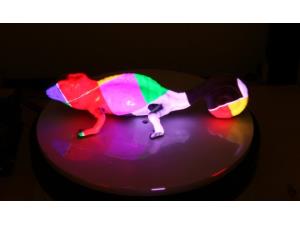



Date:13/09/19
 A team from MIT’s Computer Science and Artificial Intelligence Laboratory (CSAIL) has created ink with chameleon-like properties. Rather than reacting to mood though, the "reprogrammable ink" changes color when exposed to ultraviolet (UV) and visible light sources.
A team from MIT’s Computer Science and Artificial Intelligence Laboratory (CSAIL) has created ink with chameleon-like properties. Rather than reacting to mood though, the "reprogrammable ink" changes color when exposed to ultraviolet (UV) and visible light sources.
Different wavelengths of light emit different colors from dyed objects using this ink, the researchers say in their paper.
Dubbed "PhotoChromeleon" by the researchers, the ink is made out of a mixture of photochromic dyes that can be sprayed or painted onto objects. This can be done any number of times.
The ink is resistant to wear and tear, and can be used for outdoor shoes, the researchers say.
“This special type of dye could enable a whole myriad of customization options that could improve manufacturing efficiency and reduce overall waste,” CSAIL postdoc Yuhua Jin, the lead author on a new paper about the project, said in an MIT press release.
“Users could personalize their belongings and appearance on a daily basis, without the need to buy the same object multiple times in different colors and styles.”
"PhotoChromeleon" builds on the team's previous work on "ColorMod," which used a 3D printer to change the color of printed pieces.
The team created the "PhotoChromeleon" ink by mixing cyan, magenta, and yellow (CMY) photochromic dyes into a single solution.
Each dye interacts in a separate way with different wavelengths. Knowing this, the team was able to control which colors appeared through activating and deactivating the light sources that corresponded to different colors.
This approach could even help encourage people to keep old possessions for longer, by allowing a fresh look to be easily applied by spraying or painting the ink onto any object.
“By giving users the autonomy to individualize their items, countless resources could be preserved, and the opportunities to creatively change your favorite possessions are boundless,” says MIT Professor Stefanie Mueller.
The paper was co-authored by Jin and Mueller who worked with CSAIL postdocs Isabel Qamar and Michael Wessely and a group of MIT students.
PhotoChromeleon: MIT Researchers Create Incredible Color-changing Ink
 A team from MIT’s Computer Science and Artificial Intelligence Laboratory (CSAIL) has created ink with chameleon-like properties. Rather than reacting to mood though, the "reprogrammable ink" changes color when exposed to ultraviolet (UV) and visible light sources.
A team from MIT’s Computer Science and Artificial Intelligence Laboratory (CSAIL) has created ink with chameleon-like properties. Rather than reacting to mood though, the "reprogrammable ink" changes color when exposed to ultraviolet (UV) and visible light sources.Different wavelengths of light emit different colors from dyed objects using this ink, the researchers say in their paper.
Dubbed "PhotoChromeleon" by the researchers, the ink is made out of a mixture of photochromic dyes that can be sprayed or painted onto objects. This can be done any number of times.
The ink is resistant to wear and tear, and can be used for outdoor shoes, the researchers say.
“This special type of dye could enable a whole myriad of customization options that could improve manufacturing efficiency and reduce overall waste,” CSAIL postdoc Yuhua Jin, the lead author on a new paper about the project, said in an MIT press release.
“Users could personalize their belongings and appearance on a daily basis, without the need to buy the same object multiple times in different colors and styles.”
"PhotoChromeleon" builds on the team's previous work on "ColorMod," which used a 3D printer to change the color of printed pieces.
The team created the "PhotoChromeleon" ink by mixing cyan, magenta, and yellow (CMY) photochromic dyes into a single solution.
Each dye interacts in a separate way with different wavelengths. Knowing this, the team was able to control which colors appeared through activating and deactivating the light sources that corresponded to different colors.
This approach could even help encourage people to keep old possessions for longer, by allowing a fresh look to be easily applied by spraying or painting the ink onto any object.
“By giving users the autonomy to individualize their items, countless resources could be preserved, and the opportunities to creatively change your favorite possessions are boundless,” says MIT Professor Stefanie Mueller.
The paper was co-authored by Jin and Mueller who worked with CSAIL postdocs Isabel Qamar and Michael Wessely and a group of MIT students.
Views: 387
©ictnews.az. All rights reserved.Similar news
- Azerbaijani project to monitor disease via mobile phones
- Innovative educational system to be improved under presidential decree
- NTRC prolongs license of two TV and radio organizations for 6 years
- Azerbaijan establishes e-registry for medicines
- Azerbaijani museum introduces e-guide
- Nar Mobile opens “Nar Dunyasi” sales and service center in Siyazan city
- International conference on custom electronic services held in Baku
- OIC secretary general to attend COMSTECH meeting in Baku
- Azerbaijan develops earthquake warning system
- New law to regulate transition to digital broadcasting in Azerbaijan
- Azerbaijani State Social Protection Fund introduces electronic digital signature
- Intellectual traffic management system in Baku to be commissioned in December
- Tax Ministry of Azerbaijan started receiving video-addresses
- World Bank recommends Azerbaijan to speed up e-service introduction in real estate
- Azerbaijan to shift to electronic registration of real estate





















